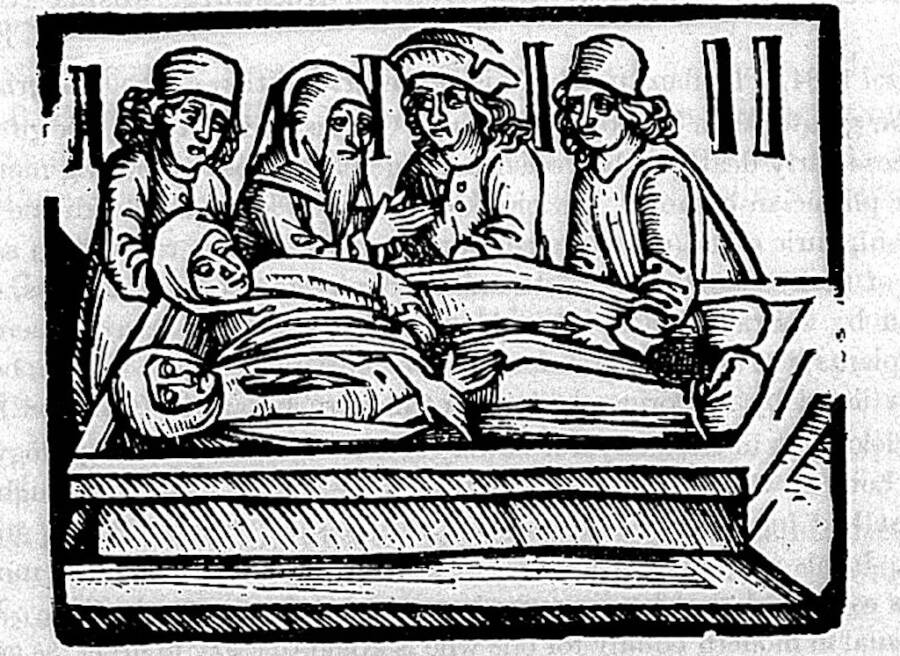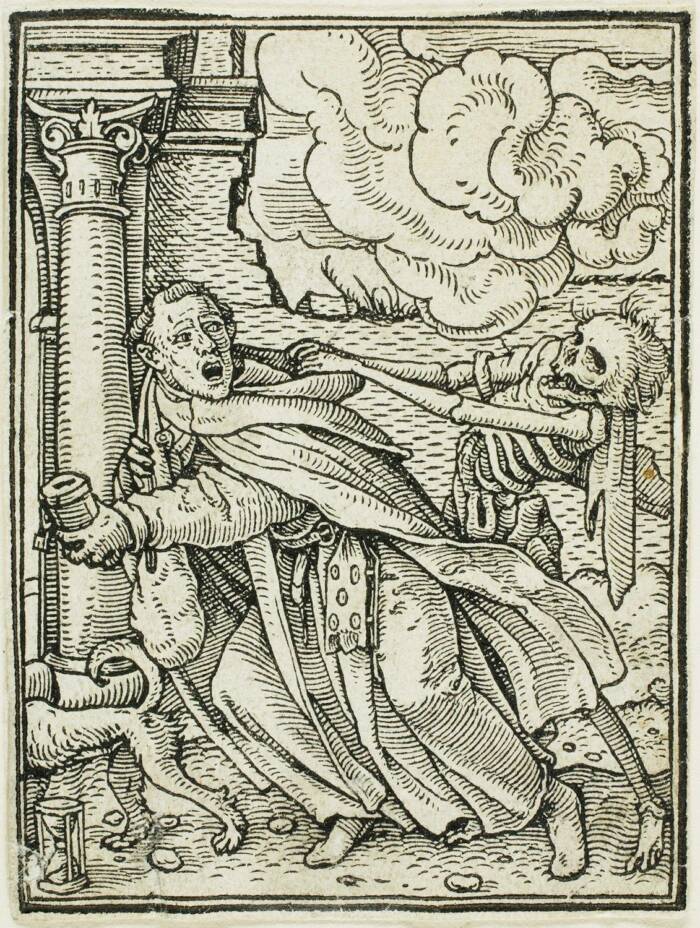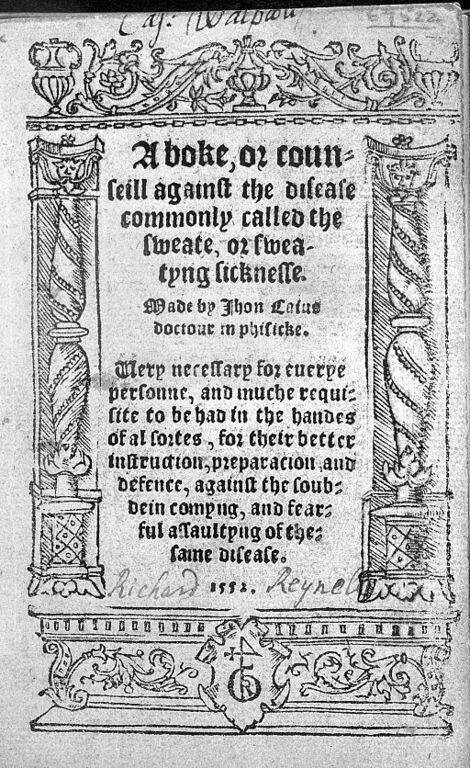Sweating sickness was so deadly that it once killed 15,000 people in England in just six weeks — but we still don't know what caused it.

Public DomainA 16th-century depiction of the sweating sickness in Strasbourg.
The symptoms came on suddenly. Chills, fever, headaches, and, of course, a terrible, drenching sweat. The so-called sweating sickness reared its head a number of times in the 15th and 16th centuries, killing thousands and terrorizing many more. But its origins remain a mystery.
The disease first emerged in 1485, shortly after Henry Tudor’s victory in the Wars of the Roses. With a mortality rate between 30 and 50 percent, it would come to define the Tudor years — and would change the course of history.
This is how the sweating sickness spread across England and Europe and then disappeared without a trace.
The Emergence Of ‘Sudor Anglicus’
The emergence of sweating sickness dovetailed with the rise of the Tudors, and would come to define the family’s reign in more ways than one.
Mention of the “sweat” was first documented in the early 1480s. According to the National Library of Medicine, the Dutch scholar Erasmus reported on it in 1483, and a similar disease was recorded in northeast England in June 1485.
Shortly before the Battle of Bosworth Field that August, Lord Stanley reportedly excused himself and his men from the fight by claiming they had the “sweat.” But instead of bowing out of the battle, he switched sides from King Richard III to Henry Tudor.

Public DomainLegend has it that after finding Richard’s crown on the field, Lord Stanley handed it to Henry Tudor — who soon became King Henry VII.
Since Lord Stanley controlled 30 percent of the king’s army, his betrayal was devastating to the royal cause. The Wars of the Roses ended with Richard’s death and Henry’s ascension as King Henry VII. And it marked the beginning of the English sweating sickness.
The battle was hardly over when Henry’s troops started to suffer from “the sweat.” Whether it came from French mercenaries in Henry’s ranks or from Rhodes much earlier is unknown. But the danger of the disease quickly became clear. Those who contracted it suffered from headaches, delirium, chills, and relentless sweat.
And within 24 hours, 30 to 50 percent of the people who got sick died.
“A newe Kynde of sickness came through the whole region,” one commentator recalled, according to The New England Journal of Medicine, “which was so sore, so peynfull, and sharp, that the lyke was never harde of to any mannes rememberance before that tyme.”
Another commentator grimly remarked that “there were some dancing in the court at nine o’clock who were dead by eleven,” according to The Sweating Sickness in England by Francis C. Webb.

Public DomainA 1493 engraving depicting the “Dance of Death.” Sweating sickness first emerged in the 1480s and returned several times in the 16th century.
With preparations for Henry’s coronation underway, London was likely more packed than usual. And the new, terrifying disease quickly spread. By the time it petered out at the end of October 1485, 15,000 people had died.
But the sweating sickness would return.
‘Everybody Is Terribly Alarmed’
After it first emerged in the 1480s, the English sweating sickness reappeared several times in the 16th century. Outbreaks took place in 1508, 1517, 1528, and 1551. Henry VII’s son and heir, Arthur, is believed to have died from the sweating sickness just before his 16th birthday in 1502.
This put Arthur’s younger brother, Henry, in line to be king. And it meant that Henry would marry Arthur’s bride, Catherine of Aragon. Henry VIII became king in June 1509, in between sweating sickness outbreaks in 1508 and 1517.

Public DomainPrince Arthur died in 1502, possibly of the sweating sickness, clearing the way for his younger brother Henry to become King Henry VIII.
Though those outbreaks were more mild than in 1485, sweating sickness returned with a vengeance in 1528.
“This disease… is the easiest in the world to die of,” French ambassador Cardinal du Bellay wrote from London in June 1528. “You have a slight pain in the head, and at the heart; all at once you begin to sweat. There is no need for a physician… you are taken off without languishing.”
Du Bellay added: “About two thousand only have been attacked by it in London… Twelve years ago, when the same thing happened, 10,000 persons died in ten or twelve days, it is said, but it was not so sharp as it is now beginning to be… Everybody is terribly alarmed.”
Alarm about the disease was not confined to London. In 1528, the sweating sickness also spread to other countries in Europe. Cases were reported in Germany, Belgium, Scandinavia, Lithuania, Poland, the Netherlands, and Russia. But it especially rattled King Henry VIII.
Henry VIII’s Fear Of The Sweat

Public DomainA depiction of death by Hans Holbein, a Tudor-era painter.
Henry VIII took extreme measures to avoid getting sick. The king reportedly slept in different beds every night, broke up his court, and spent the summer of 1528 moving from safe house to safe house in the countryside. When his mistress, Anne Boleyn, fell ill, Henry VIII was so anxious about catching “the sweat” that he kept his distance.
“There came to me suddenly in the night the most afflicting news that could have arrived,” he wrote to Anne, sidestepping the fact that he would not fly to her side. “The first, to hear of the illness of my mistress, whom I esteem more than all the world, and whose health I desire as I do my own, so that I would gladly bear half your illness to make you well.”
He sent his second-best physician, William Butts, to her side instead.
Though Anne survived her bout of the sweating sickness, many did not. While the sickness afflicted the rich and poor alike, The National Library of Medicine reports that the sweating sickness seemed especially fatal for wealthy, upper-class adult males, and many within the Tudor ranks were impacted by the disease. This led Henry’s advisor, Thomas More, to quip that “one is safer on the battlefield than in the city.”
The fatal disease returned just once more, in 1551. Then — though a possible variant emerged about 150 years later in Picardy, France — it seemingly vanished.
So what was it?
What Caused The Sweating Sickness?
No one understood the sweating sickness back in the 16th century — though not for lack of trying. In 1552, a doctor named John Kays, who rebranded himself as Johannus Caius, published The Sweating Sickness: A boke or counseill against the disease commonly called the sweate or sweatyng sicknesse. He suggested that people avoid “evil mists” and rotten fruit and that those who fell ill should drink herbal concoctions and avoid going outdoors.
“They which had this sweat sore with peril of death were either men of wealth, ease or welfare, or of the poorer sort, such as were idle persons, good ale drinkers and tavern haunters,” Caius counselled his readers.

Public DomainJohn Kays, better known as Johannus Caius, wrote about the sweating sickness in the 16th century. But neither he nor modern doctors completely understand what caused the illness.
Caius didn’t understand the disease that well — many of his wealthy patients perished — but modern-day doctors haven’t done much better. Today, no one is sure what caused the sweating sickness.
Different theories have emerged, however. Scholars have suggested that influenza, scarlet fever, anthrax, or typhus could have caused the sweating sickness. Others believe that it was caused by hantavirus, which can be spread by rodents and produces similar symptoms.
But no one disease has been definitively linked to the sweating sickness.
In the end, sweating sickness is as mysterious today as it was over 500 years ago, when it appeared in a rush of aches, delirium, and drenching sweat — and killed many of its victims within 24 hours. What caused it? We still don’t know. And we still don’t know if this deadly disease will ever return.
After reading about sweating sickness, see how the mysterious Dancing Plague of 1518 caused people to dance so hard they dropped dead. Or, go inside the disturbing history of the Black Death and the plague doctors who treated it.





